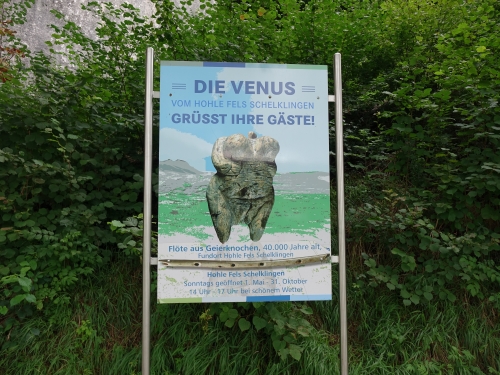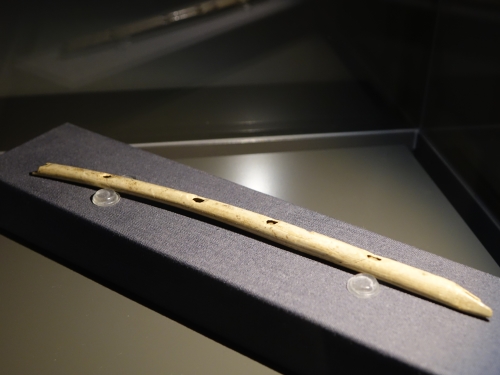Blog WHS Visits
WHS #638: Ice Age Art Caves
The Caves and Ice Age Art in the Swabian Jura was a welcome addition to the WH List this year for those ticking off Western European WHS on weekend trips. Recent reviews of it by Hubert and Clyde have already paved the way regarding all practical details necessary for a worthwhile trip. The site lies some 620km from my home, and I visited it by car with a stop-over in Darmstadt. I decided to not visit all locations, but instead do some cherry picking among the inscribed caves and associated museums with a special focus on seeing the figurines.
 My day of exploration started at the Archäopark Vogelherd. At the park entrance there is a small exhibition room, and that’s where I found my two first figurines: a mammoth and a cave lion. Both are tiny objects. They are on show in a display case each, and there’s nothing else in the room. The mammoth is easy to recognize as such and is in perfect shape. It has to be admired from the “front” though, as the other side is much more rough. This seems to suggest that it was a brooch or similar ornament worn on clothing or the body.
The other figure is said to represent a cave lion. With some imagination a tiger or a puma as we now know them can be seen in the object. “Cave lions” were widespread in the age of the early homo sapiens and could grow bigger than modern lions. They probably had no manes, hence the similarity with other big cats rather than male lions. They did not really live in caves (phew!) but did sometimes enter them to surprise a hibernating bear.
In this Lone River Valley area I also visited the Vogelherd and Hohlenstein Stadel caves. Both are fairly large, enough to provide a shelter to families during the harsh winter time.
My day of exploration started at the Archäopark Vogelherd. At the park entrance there is a small exhibition room, and that’s where I found my two first figurines: a mammoth and a cave lion. Both are tiny objects. They are on show in a display case each, and there’s nothing else in the room. The mammoth is easy to recognize as such and is in perfect shape. It has to be admired from the “front” though, as the other side is much more rough. This seems to suggest that it was a brooch or similar ornament worn on clothing or the body.
The other figure is said to represent a cave lion. With some imagination a tiger or a puma as we now know them can be seen in the object. “Cave lions” were widespread in the age of the early homo sapiens and could grow bigger than modern lions. They probably had no manes, hence the similarity with other big cats rather than male lions. They did not really live in caves (phew!) but did sometimes enter them to surprise a hibernating bear.
In this Lone River Valley area I also visited the Vogelherd and Hohlenstein Stadel caves. Both are fairly large, enough to provide a shelter to families during the harsh winter time.
 In the early afternoon I arrived near the other cluster of sites, in the Ach Valley. I started at the Urgeschichtliches Museum in Blaubeuren. This undoubtedly is THE museum to go and see when you want to learn more about the Ice Age Art of this region. It displays various attributes such as the raw materials (mammoth bones) and the tools that were used. Most objects that are shown were found at the nearby Hohle Fels Cave. In this museum I saw my first examples of the “earliest musical instruments”, one of the claims to fame of this WHS. The flowery description in the nomination file might suggest early pianos or harps, but these “instruments” are all flutes.
The museum also has a number of figurines. There is a diving bird (looks like a duck), a tiny lion man and the prize piece of the collection: the Venus of Hohle Fels, "the oldest undisputed example of a depiction of a human being yet discovered". This one even has a whole exhibition room to itself! The female figurine was only discovered as recent as 2008.
I ended my day at the Hohle Fels cave. This was a pleasant surprise as well. It really is a huge cave. A music group was performing inside, using “ancient” instruments.
In the early afternoon I arrived near the other cluster of sites, in the Ach Valley. I started at the Urgeschichtliches Museum in Blaubeuren. This undoubtedly is THE museum to go and see when you want to learn more about the Ice Age Art of this region. It displays various attributes such as the raw materials (mammoth bones) and the tools that were used. Most objects that are shown were found at the nearby Hohle Fels Cave. In this museum I saw my first examples of the “earliest musical instruments”, one of the claims to fame of this WHS. The flowery description in the nomination file might suggest early pianos or harps, but these “instruments” are all flutes.
The museum also has a number of figurines. There is a diving bird (looks like a duck), a tiny lion man and the prize piece of the collection: the Venus of Hohle Fels, "the oldest undisputed example of a depiction of a human being yet discovered". This one even has a whole exhibition room to itself! The female figurine was only discovered as recent as 2008.
I ended my day at the Hohle Fels cave. This was a pleasant surprise as well. It really is a huge cave. A music group was performing inside, using “ancient” instruments.
 I always thought that when I really had money I would start collecting Netsuke – Japanese miniature sculptures. These small Ice Age figurines, mostly made out of mammoth bone, reminded me of them. There are so few left (about 50). But even in this day and age they can be admired as art objects.
I always thought that when I really had money I would start collecting Netsuke – Japanese miniature sculptures. These small Ice Age figurines, mostly made out of mammoth bone, reminded me of them. There are so few left (about 50). But even in this day and age they can be admired as art objects.
Signs everywhere
A flute made out of bone of a griffon vulture
Sediments from the Aurignacian and the Neandertaler periods
Els - 13 August 2017